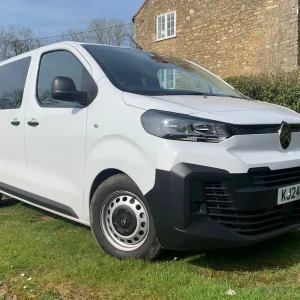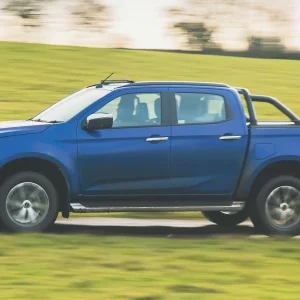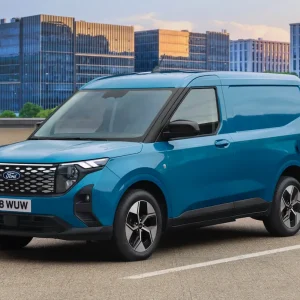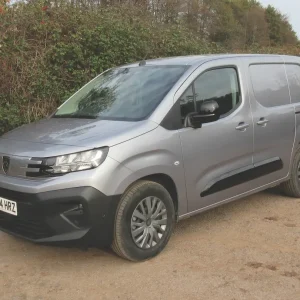
While diesel may have been comprehensively demonised, sales of vans that use the fuel still vastly outnumber those of battery-powered models.
Rising concern over air quality and an increasing willingness among city authorities to slap restrictions on the most polluting vehicles should mean that electric LCVs will win out long-term however, just so long as manufacturers can successfully address worries about range anxiety.
Nissan has been doing exactly that with the introduction of a new version of its front-wheel drive eNV200, which it says can travel a lot further between recharges than its predecessor.
Winner of the Green category in the 2019 What Van? Awards, the latest model promises a range of between 124 miles and 187 miles (WLTP – Worldwide Harmonised Light Vehicle Test Procedure – City and Combined cycle) thanks to the use of a 40kWh battery. That’s a 60% improvement on the old model and its 24kWh battery.
Three spec levels are listed – from entry-level Visia, through Acenta and up to Tekna, the model we sampled.

Load bay
Entry to the load area is via asymmetric doors at the back and a sliding door on each side of the 4.2m3 cargo body.
The narrower of the two rear doors is on the offside, and both can be pushed through 180° once you release the user-friendly stays. All you need to do in each case is tug a flap.
Half-a-dozen floor-mounted load tie-down points are fitted plus two sliding ones above each of the wheel boxes. There’s a full-height steel bulkhead too.
The load floor is defended against scratches and scrapes by a tailored rubber mat. Sound-deadening panels on the sides and doors give some protection against minor damage, but getting the entire cargo box timbered out might be a wise precaution.
The gross payload is 705kg and the latest eNV200 can haul a trailer grossing at up to 410kg. But doing so has implications for the van’s range.


Interior and equipment
Drivers of diesel vans should adapt reasonably easily to the in-cab environment. The shift lever is not too dissimilar to that typically found in an automatic van, with park, neutral, reverse and drive settings. Nor is a starter button, that only works if the key fob is present, unusual these days – many diesel LCVs have one. The green ‘Eco’ button that restricts performance to increase range isn’t that novel either.
In-cab features include a good-quality MP3/iPod-compatible radio/CD player with steering wheel-mounted controls, satnav – that tells you where the nearest publicly accessible charging stations are – Bluetooth, climate control and an aux-in socket. With reverse engaged a rear-view camera shows what is behind the vehicle on the dashboard’s touch-screen.
A button on the dashboard allows you to lock and unlock all the doors.
Electric windows and electrically adjustable exterior mirrors are included in the package and our test van was fitted with an optional Cold Pack. It consists of a heated steering wheel, heated front seats, and heating elements for the aforementioned mirrors. But given that such items draw power from the battery we’re not sure it’s entirely wise to specify such a pack on an electric van.
In-cab storage space includes bins in each of the doors and a lidded glovebox, all of which are on the small side. However, they are supplemented by a shelf on top of the dashboard, which will take an A4 pad, and a cup-holder at either extremity of the fascia.
A roomy lidded box sits between the front seats along with a tray, two more cupholders and some slots that could be used for small change. The passenger seat back flips down and turns into a desk and there’s a drawer beneath the seat to conceal items.
The steering column is height-adjustable – although the adjuster on our demonstrator kept sticking – but the driver’s seat is not, an omission that needs rectifying.
Independent suspension with MacPherson struts helps support the front while a torsion beam axle does the same for the rear. Our test van’s 15in alloy wheels wore Goodyear Efficient Grip 185/65 R15 tyres. A full-size spare wheel is standard.
Electric power steering is fitted. It delivers a 10.6m turning circle kerb-to-kerb and 11.13m wall-to-wall.
All the usual onboard safety aids are installed. As well as a tyre pressure monitoring system they include ABS, electronic stability programme, electronic brakeforce distribution, hill-start assist and traction control, which can be switched off.
Disc brakes are fitted all round and front fog lights are standard, as is a full airbag pack with driver and passenger airbags. An alarm is included along with a trip computer and rain-sensing windscreen wipers.

Engine and gearbox
Power comes courtesy of an 80kW (109hp) AC synchronous electric motor married to a single-speed step-less transmission.
It takes power from a 40kWh 360V 192-cell laminated lithium-ion battery that sits under the load floor in a reinforced area, which should hopefully protect it in a collision. Maximum torque is 254Nm.
Driving
Press the brake pedal, ensure the shift lever is in ‘P’ for park, then press the starter button – the instrument panel lights up, which means you can get going. All you need to do then is push the lever into ‘D’ for drive, release the handbrake and you’re away. An electric motor delivers all the torque it has available immediately, so acceleration from rest is strong and continues to be so as you pick up speed.
A light right foot is called for in order not to deplete the battery too soon.
Despite the promises of a longer range, it is difficult not to keep checking the dash display to see how many more miles you can travel before recharging. The range starts to drop quickly if you have the heated seats, heated steering wheel and cab heater all switched on in chilly winter weather.
To maximise range press the Eco button, although doing so affects the van’s performance noticeably, and more so than on the previous model. Something else you can do is push the shift lever into the ‘B’ for braking position. That increases the level of regenerative braking and means energy that would otherwise be lost is funnelled into the battery pack. ‘B’ also helps to slow the vehicle on steep descents. It is as though the van has been fitted with a retarder, and means you make less use of the foot brake.
The Nissan’s handling could stand to be a bit sharper and the ride could be better damped. On the positive side, however, the eNV200 is easy to manoeuvre at low speeds and is undoubtedly quiet. While that is good news for the occupants, remember that cyclists and people crossing the road use their ears as much as their eyes, so may not be aware of your presence until you are almost on top of them.
So make sure the Vehicle Sound for Pedestrians (VSP) system is switched on. Operating at around-town speeds of below 19mph, it lets people know you are in their vicinity – assuming that they are not wearing headphones, of course…
With the dashboard display telling us we could travel 150 miles, we drove from Ross-on-Wye in Herefordshire to Newport in South Wales – an 80-mile non-stop daytime round trip in dry, still, weather.
We travelled on A-roads for the most part, made extensive use of the Eco button, kept the seat and steering wheel heaters switched off, and used the lightest of light touches on the accelerator, tickling the Nissan along wherever possible. We had a token 100kg load in the back, and did not use cruise control, which is a standard feature and includes a speed limiter.
So did we get back without any mishaps? We did – with an indicated 40 miles to spare. But had we switched on everything possible, forgotten about the Eco button, pressed the pedal to the metal and been heavily laden, we might only have reached Monmouth on the return leg of the trip.


Operating
A 6.6kW AC onboard charger is fitted, and if you flip up a hatch at the front of the vehicle you will uncover two charging ports.
One can take power from an ordinary domestic supply while its stablemate is intended for 50kW DC rapid charging. Cables are provided for both.
Completely recharging the battery from zero should take 7.5 hours assuming you have access to a 32A wall-box, says Nissan.
You will need to allow a lot more time, however – a painful 21 hours and 30 minutes – if you are relying on a standard three-pin socket.
Use a rapid-charger and you should be able to get to 80% capacity in around 40 to 60 minutes, Nissan states.
The cost of the electricity used to propel the eNV200 can be measured in pennies per mile.
The government’s Plug-in Van Grant cuts the purchase price of electric light commercials by 20% up to a maximum of £8,000.
In our demonstrator’s case that brings the price down to £21,881 on-the-road excluding VAT.
To these savings can be added zero-rated Vehicle Excise Duty, exemption from the London Congestion Charge, and free access to the upcoming London Ultra Low Emission Zone.
Nor will there be any charge to enter the Clean Air Zones that will be rolled out across selected urban areas around the UK over the next few years.
Bear in mind too that London mayor Sadiq Khan has announced a scrappage scheme to encourage businesses in the capital to replace their old vehicles with newer, cleaner models, including electric ones.
Bi-directional charging technology is fitted, which allows excess energy stored in the battery pack to be sold back to the grid – a potentially useful source of income.
Using the NissanConnect app, eNV200 operators can check on the level of battery charge remotely, start the charging process and set the onboard climate control system to the desired temperature.
Service intervals are set at 12 months/8,000 miles while the warranty lasts for five years/60,000 miles.
Most importantly, the battery’s charging capacity is warranted for eight years/100,000 miles.
Finally, the anti-corrosion warranty lasts for 12 years.
Nissan eNV200 Tekna 40kWh
Price (ex VAT) £28,719**
Price range (ex VAT) £25,219-£28,719**
Gross payload 705kg
Load volume 4.2m3
Load length 2,040mm
Load width (min/max) 1,220/1,500mm
Load bay height 1,358mm
Loading height 523mm
Rear door aperture 1,262 x 1,228mm
Side door aperture 700 x 1,171mm
Gross vehicle weight 2,220kg
Braked trailer towing weight 410kg
Residual value 19.7% (24.6%)*
Cost per mile 40.7p (32.2p)*
Engine size/power 80kW (109hp) AC synchronous electric motor
Torque 254Nm
Gearbox Single-speed step-less
Range 124-187 miles (WLTP city & combined cycle)
Battery 40kWh laminated lithium-ion
Warranty 5yrs/60,000mls
Service intervals 1yr/8,000mls
Insurance group 12E
Price as tested £28,999
*after 4yrs/80,000ml
source: KwikCarcost (Figures in brackets with Plug-in Van Grant)
** Before Plug-In Van Grant
Options Fitted
Cold Pack £280
Rivals
Peugeot Partner Electric
Price (ex VAT) £22,850-£23,450
Load volume 3.3-3.7m3
Gross payload 552-636kg
Engines 37kW
Verdict: Anybody expecting to see battery-powered new Peugeot Partners will have to wait until next year. In the meantime, Peugeot and sister brand Citroen (Berlingo Electric) are continuing to market the electric versions of the previous models, which offer less range than their key rivals. Front-end price is lower though.
Renault Master Z.E.
Price (ex VAT) £53,700-£56,800
Load volume 8.0-13.0m3
Gross payload 975-1,128kg
Engines 57kW
Verdict: The fact that we’re highlighting a model that is a lot bigger than the other vans referred to goes to show how few electric vans from mainstream brands are on-sale right now as opposed to being somewhere in the pipeline. This one has plenty of cargo space but does not come cheap, and at 74 miles is a little short on range.
Renault Kangoo Van/Kangoo Van Maxi Z.E
Price (ex VAT) £24,200-£27,600
Load volume 1.3-4.0m3
Gross payload 605-640kg
Engines 44kW
Verdict: Now with a 33kWh battery and a longer range as a consequence, the latest electric Kangoos come with an upgraded single-phase 7kW AC charger, which can take the new battery to full charge in six hours, says Renault. Range is competitive, but sister brand Nissan’s e-NV200 offers more carrying capacity.
The Final Verdict
|
Design |
8/10 |
Sensibly crafted with most of the features operators will need. |
|
Cabin |
7/10 |
Pleasant enough with clear dashboard displays. |
|
Ride |
6/10 |
Too choppy, but improves when the van is laden. |
|
Refinement |
8/10 |
Ultra-quiet both internally and externally. |
|
Load area |
8/10 |
Usefully sized and easy to access, it has a respectable payload. |
|
Handling/performance |
7/10 |
The former could be a lot sharper, the latter is impressive. |
|
Engine/transmission |
8/10 |
No lack of power, and the transmission delivers it smoothly. |
|
Standard equipment |
9/10 |
Acenta-trimmed models are well kitted-out. |
|
Operating costs |
8/10 |
Ultra-low, and the warranty package is praiseworthy. |
|
What Van? subjective rating |
8/10 |
Best EV van around. Viable for city/suburbs, and a bit further out. |





